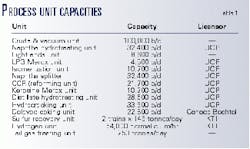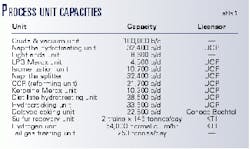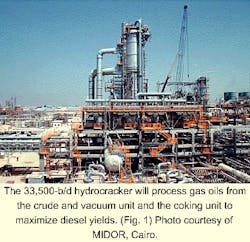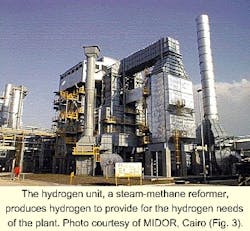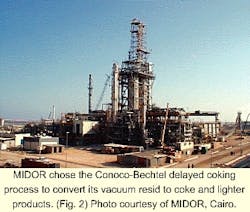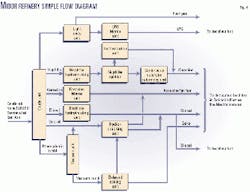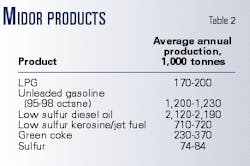Middle East Oil Refinery (MIDOR) is building Egypt's first refinery to involve private investment, one of the largest grassroots refineries to start up this year.
The $1.2-billion refinery being built in the Ameryia Free Zone of Alexandria will have a capacity of 100,000 b/d (5 million tonnes/year-tpy).
When complete in May 2001, the refinery will be one of the most sophisticated in the Mediterranean area. It aims to produce high-quality products for both domestic and export consumption. Local markets especially need the LPG and diesel products from this refinery.
MIDOR has seven shareholders: Egyptian Petroleum Corp. (EGPC; 40%), Britain's BVI Medor (20%), Cayman Island's NBE Finance (16%), Egypt's Petroleum Projects & Technical Consultations Co. (Petrojet; 10%), Egypt's Engineering for the Petroleum & Process Industries (ENPPI; 10%), Switzerland's Masaka (2%), and Egypt's Suez Canal Bank (2%). Petrojet and ENPPI are subsidiaries of EGPC.
Thus, Egypt's public sector owns 60% of MIDOR, while various private entities own 40%.
Process units
Table 1 lists the major new units in the high-conversion refinery. It has a 100,000-b/d crude and vacuum unit, a 21,700-b/d catalytic reformer (CCR) licensed by UOP LLC, and a 33,500-b/d hydrocracker (Fig. 1) licensed by UOP. The Conoco-Bechtel alliance provided its delayed coking technology in a 22,800-b/d unit (Fig. 2).
The hydrogen reformer (Fig. 3) and the CCR provide the refinery's hydrogen needs.
The processes have a slant towards diesel production. MIDOR says its production will help meet increasing local demand of LPG and diesel.
Fig. 4 shows a simple flow diagram of major units in MIDOR's refinery.
The refinery has two flare systems, one for sour gases and the other for nonsour gases.
The plant is considering advanced process control for the near future. For this project, refinery off sites pipelines and the Dekheila Port loading facilities will be controlled by a supervisory control and data acquisition (SCADA) system, integrated with the refinery's distributed control system (DCS).
Supporting companies
Ownership and responsibilities within the refinery are divided among sister companies: MIDOR, Middle East Tankage & Pipelines (Midtap), Midor Electricity Co. (Midelec), and Middle East Water Co. (Midwater).
MIDOR and Midtap share the facilities within the refinery's fence. MIDOR owns the process units while Midtap owns the utilities and off site facilities.
Midtap facilities, an investment of $400 million, include crude and product-storage tankage, crude and product pipelines, power-distribution facilities, and the Dekheila Port facilities on the Mediterranean Sea.
Midelec supplies electric power for the refinery, using the national grid as a backup. Midelec is a three-train x 50-Mw gas turbine power-generation plant with a supply capacity of 124 Mw.
Midtap has a 49% interest in Midwater, which supplies process water for plant operations. Italian company WTD (Water Treatment Desalination) owns 20% of Midwater's $2.3 million investment.
Project engineering
Paris-based Technip is handling the engineering, procurement, and construction of the entire refinery as a lumpsum, turnkey project.
Construction to date, said MIDOR, is on budget. Technip began detailed engineering in February 1998.
Technip has enlisted the help of several subcontractors for the project. Petrojet and ENPPI, both from Egypt, Daelim from Korea, and Tecnicas Reunidas SA from Madrid are handling various EPC jobs.
Roberts & Schaefer Co., Chicago, is the main construction contractor for the coke handling facilities.
ENPPI and Soros Associates Inc., Chicago, are the engineering and procurement contractors for the crude and product pipelines as well as the Dekheila Port product exporting facilities. Petrojet and Archirodon of Saudi Arabia, are also main construction contractors for these facilities.
During the 2.5-year construction period, MIDOR and its contractors will have employed up to 7,500-8,000 persons. After start up, about 800 Egyptian employees will operate, maintain, and manage the refinery.
In November 2000, MIDOR awarded a 5-year contract to Foster Wheeler International Corp. to operate and maintain its refinery. The contract will be executed through FW Management Operations Ltd., a part of Foster Wheeler Corp., which has created a local Egyptian company to operate and maintain the facility. This approach maximizes employment of Egyptian qualified personnel.
Feed and products
The feed to the new 100,000-b/d refinery will be a wide spectrum of Arabian crude, ranging from 100% Arabian Light to 50% Arabian Light/50% Arabian heavy crude (or an equivalent mix).
Refinery products will meet European Union standards for 2005. Unleaded high octane gasoline and low-sulfur diesel make up the largest part of the intended products.
The MIDOR refinery will produce an average of 1.3 million tpy of gasoline and 2.2 million tpy of diesel. Table 2 lists other products and their annual production rates.
Generally, all of the refinery's LPG and diesel production will head for domestic consumption, and the remaining products (gasoline, kerosine/jet fuel, coke) will be exported to international markets.
Diesel and LPG contracts for domestic and export use have already been signed, said the company.
Environmental considerations
MIDOR designed the refinery to be well within local Egyptian environmental standards according to Law 4/1994 that governs pollutant emissions in Egypt from various activities. Maximum allowable limits of SOx, NOx, and noise are 60 µg/cu m, 400 µg/cu m, and 75 dB at 1 m from each equipment.
Woodward-Clyde Consultants, Omaha, Neb., prepared the preliminary environmental impact assessment report submitted to MIDOR and the Egyptian Environmental Affairs Agency (EEAA). The EEAA issued preliminary permits based on this report.
MIDOR received its final permit for implementation after Woodward-Clyde reassessed the work based on the refinery's detailed design.
The company intends to carry out environmental monitoring and reporting for expected emissions and waste disposal from the refinery, pipelines, and Dekheila port facilities.
Regularly monitored air emission components include SOx, NOx, volatile organic compounds (VOCs), and particulate matter and stack emissions. Water monitoring includes surface-water monitoring, underground water monitoring, effluent monitoring, and port-ballast water treatment monitoring.
In addition to air and water monitoring, the refinery will conduct regular noise monitoring within the refinery boundaries.
The MIDOR refinery uses an API separator, an induced air flotation (IAF) unit, and a biological treatment unit to treat and remove oily water and sludge from the waste water. These solids are routed to the coking unit.
